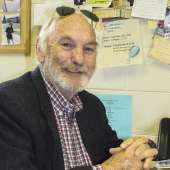The Ferguson fiasco
After almost two weeks of nightly confrontation between black citizens and a militarized police force, some calm has returned to Ferguson, Missouri. It all started in the afternoon of Aug. 9 when a white Ferguson police officer shot and killed a black unarmed teenager, Michael Brown.
The details of that shooting varies depending on who you talk to, as is almost always the case.
A companion of his, Dorian Johnson, 22, told the media that he and Brown were minding their own business when a police officer ordered them off the street where they were walking and onto the sidewalk. The officer then grabbed Brown around the throat. Brown struggled to free himself and the officer drew his gun and started firing (Time magazine, Aug. 25).
Later, a surveillance video of a store that Brown and Johnson were in displayed a significantly different picture, one of Brown attempting to walk out of the store with an item he hadn't paid for, being confronted by the store owner and physically pushing him back before leaving. In most jurisdictions that would constitute strong-armed robbery which is a felony.
But the story we've been inundated with daily since that event happened was not the event itself but the aftermath of the event. Blacks gathered in the street to protest the killing of an unarmed teenager by a white police officer, regardless of the reason, and those protests were met by a police department that looked more military than law enforcement This exacerbated the already existing problem and the number of protesters grew each night, buoyed by out of town blacks, some who came to Ferguson to burn and loot rather than protest. Eventually the highway patrol was ordered in by the governor and later the National Guard before the situation finally began to wind down.
Blame for these two weeks of violent and destructive behavior cuts both ways. Police officers are taught and trained to only use deadly force when their or someone else's life is in imminent danger and that wasn't the case in regards to an unarmed teenager. On the other hand, that teenager had just committed a felony crime and was physically an imposing figure. The officer may have panicked or may have simply used the situation as a reason to kill a member of a group that he didn't like. We'll never know because it's impossible to get inside someone's head if they don't want us there. It's also easy to understand the sentiment of the community which is two thirds black being patrolled by a police department that is predominantly white. Racism still exists on both sides whether we want to admit it or not.
So all of the elements for a confrontation between blacks and whites were present and everyone knew it would only take a spark to ignite the bomb. That spark came in the form of jack-booted police officers dressed in riot gear, piloting armored vehicles, pointing their weapons at unarmed citizens, firing tear gas and rubber bullets at them and the result was almost two weeks of nightly conflict that captured the eyes and ears of people world wide.
Situations like this can be resolved and stopped before they start but that responsibility lies with law enforcement and not the people. The people are unorganized and have no official leader and law enforcement agencies do. For example, New York City reduced the number of police shootings from 314 in 1971 to 16 in 2012 by careful hiring and training of their police officers. (Time magazine, Aug. 25.)
Racism has always existed in police departments and it still does. We can't stop what goes on in a person's mind but we can prevent that mindset from taking action if the penalties for doing so are severe enough.
Michael Brown used his size and strength as a weapon to have his own way. By watching his behavior on the store surveillance video, he acted like a thug and a bully, doing what he wanted to do rather than abiding by the law. But that wasn't sufficient reason to shoot him dead.
Calmer heads have to prevail in the future and our media cannot continue to be one-sided as has been the case for the last several years. I watched conservative television shows which defended the actions of the police and liberal television shows who blamed only the police and I heard the same divergent views here in McCook.
One person asked why the police didn't just pull back and let the demonstrators do their thing. That was tried by police chief Darryl Gates in Los Angeles after L.A. police officers were acquitted for the beating of Rodney King which was captured on video tape by another citizen. Gates idea was to let the protesters blow off steam without police intervention. That resulted in one of the worst riots in American history with stores looted, people beaten severely and a significant section of that neighborhood in Los Angeles burned to the ground. So doing nothing isn't a solution either.
When things like this happen, neither side is without blame.

